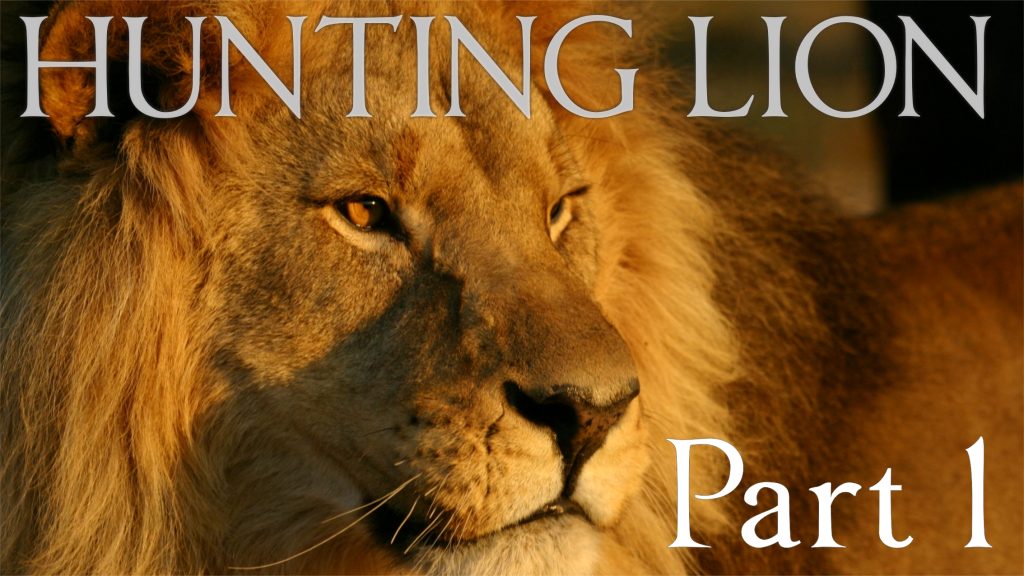Introduction
Hunting lions with a rifle or bow – if done properly (i.e. not “canned”) – can be an exciting, possibly dangerous adventure, that will be remembered for the rest of your life. It is not for the faint-hearted as lions can be unpredictable and can put one’s courage to the test in certain circumstances.
General Description of the Species
Lions have the typical body profile of a big cat with a powerful muscular body, short robust legs, large paws, shoulders that project above the spine when walking, and an extremely long tail that serves as a counter-balance when running or charging

The body is sandy or tawny-yellow on the upper parts and flanks, and a light yellow to white on the underparts and inner legs. Adult males have a mane of dense, dark, tawny hair around the neck and down the throat between the front legs. Kalahari lions tend to have better-developed manes compared to lions from the sub-tropical bushveld.
Lions have yellow eyes which can be very intimidating when they “lock on” to you.
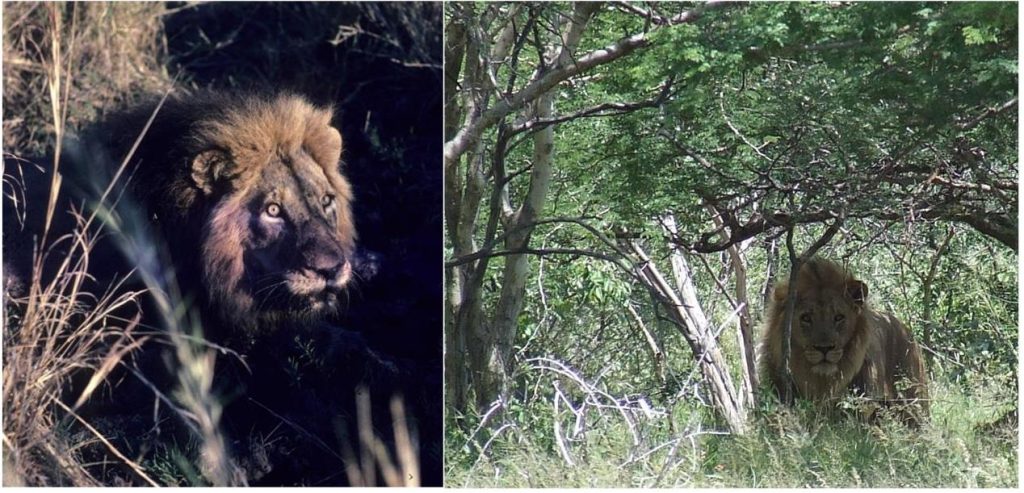
Adult males weigh around 200 kg. and stand approximately 125 cm at the shoulder whereas females weigh about 140 kg. and stand 100cm at the shoulder.
BEHAVIOUR AND HABITS
Lions inhabit almost any type of habitat, with the exception of the forest. They may be found from the desert and arid Karoo to grassland, savannah, bushveld, valley thicket, and mountain kloof thicket, where rainfall can vary between these habitat types from less than 100 to more than 1200 mm per annum. The topography within these habitats where lions may be encountered includes flat plains, rocky hills, and riverine vegetation.
Tall grass, bush, tree shade, and rocks are necessary to provide concealment when stalking prey, as well as for providing shelter and cover during the heat of the day. Surface drinking water is essential as lions are water-dependent.
Lions are predators and carnivores but are opportunistic feeders and will feed on any live or strange object that may present as a potential food source. Their diet includes insects, rats, mice, reptiles, ground birds, small and large mammals. Blue wildebeest, zebra, buffalo, giraffe, kudu, warthog, and impala are favourite prey species. The author has on two occasions observed lions attack and later feed on full-grown rhinos (black and white) although this should be regarded as highly unusual. Lions use defined strategies when hunting. The basic strategy is for designated individuals in the pride to make themselves seen and to flush prey whilst other members of the pride lie in ambush along flight paths taken by fleeing prey animals.

The preferred prey size is a live mass of 60-350 kg. but some prides specialize in bringing down prey species much larger than this, such as giraffes and buffalo.

Although lions are mainly nocturnal their activity is not restricted to dark hours of the night. They move between 11 to more than 30km in a night. They are often active on cool, overcast days. Generally, though lions tend to rest and sleep during the warmer daylight hours in areas providing them with cool shade. They will sometimes climb into trees to rest on large branches or to get to a leopard kill.
Hunting success is significantly higher for prides (15% to as high as 95%) than for individuals (2.5% to 29%). Hunts usually terminate in a short rush over distances of 100 – 200m when lions can attain speeds of up to 60 km/h.
Dominant males feed first at a kill or food source and will attack any female or youngster attempting to intrude. After the male has had his fill or has been feeding for a while the pride’s dominant female, her subordinates, and small cubs will be afforded the opportunity to feed. Sub-adults are the last in line to eat.
Lions do not feed every day but when they do kill, on average once every 4 days, they will consume up to 45 kg. of meat. Lions may return on a number of occasions to feed on the carcass of a large animal.
Lions are the only cat species that live in gregarious groups referred to as prides. Old males – past their breeding prime and sick or injured lionesses may occur as nomadic individuals.
Lions reach sexual maturity at the age of 20-24 months. The first mating will, however, only occur between the ages of 2½ to 4 years in females and 4½ to 5 years in males. Mating occurs year-round. Mating lions usually move off from the pride and can be very aggressive.

Young are born after a short gestation period of 110 days. Lionesses with newborn cubs remain in solitude for the first month after birth. Cubs are weaned at the age of 6-12 months.
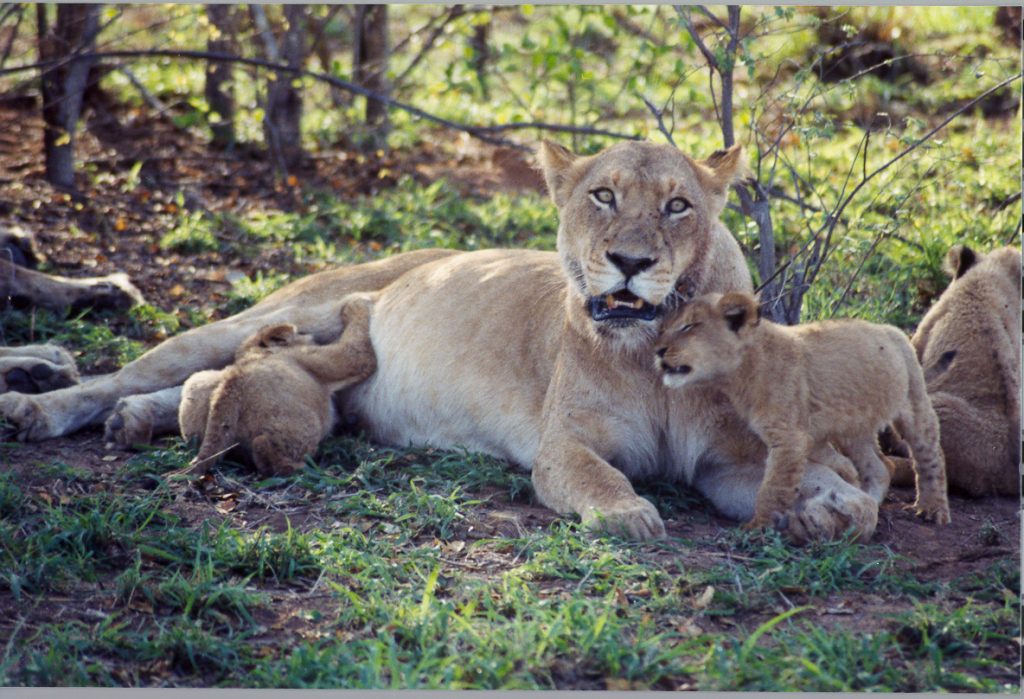
Dominant females form the nucleus of lion society and lead the pride, dominating the males and subordinate and sub-adult females.
Most female cubs remain in the pride for life.
A pride generally is made up of 2-4 alpha males, 4-10 alpha and beta lionesses of different ages, and several sub-adult females and cubs of both sexes. The size of prides varies according to the density of potential prey in an area.
On reaching sexual maturity at 20-24 months, brothers leave the pride as a bachelor nomadic group and remain in beta status until they reach social maturity at the age of 5 years. The group of alpha males then approaches existing prides in order to challenge and replace the existing alpha males. If and when they succeed in doing so they tend to kill all existing cubs in the pride to ensure that only their own genes are passed on to future offspring. This is referred to as infanticide.
Any new alpha lion brother that has replaced the old alpha individual/s – who may be killed or evicted from the pride – may mate with a willing alpha or beta lioness. The alpha brothers remain permanently with the pride for 4-5 years until they in turn are replaced by a new, stronger brother group. Once defeated, an alpha brother group again becomes nomadic, either as an intact group or splitting into post-mature solitary animals.
Lions live to the age of 14-16 years of age in the wild.
Hunting the Species
Africa’s lion population has shown a sharp decline over the past decade and if this trend continues and the species conservation status edges towards endangered then the opportunity to hunt lions in the wild may decline in the foreseeable future. A moratorium and restriction on lion hunting is already in force in a number of African countries.
Conservation status
The IUCN has lion now classified as a vulnerable species with a population reduction of 50% or more over the last 10 years.
Sign and tracking
Tracks
Lion tracks are classified as paws without claws.
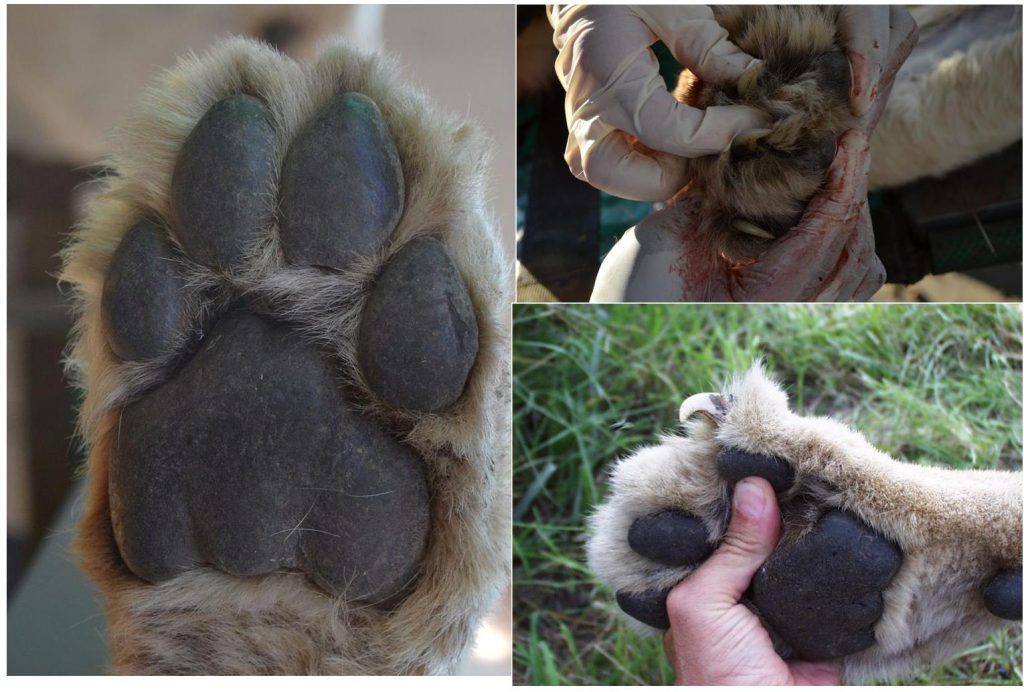
Although lions do possess claws they do not normally register when walking as they are retracted but may be present when lions are running at speed. Four toes show up in the tracks.

Tracks are easier to find along bush tracks, along dry riverbeds, on bare ground, and at waterholes.

Scats/droppings:
Lion scat is deposited randomly. It is extremely bad smelling, and dark (very dark brown to black) when fresh. It becomes lighter as the scat ages and weathers. It generally contains hair, and crushed bones and may also have undigested hooves of smaller prey species such as impala, warthog, and kudu.

Feeding sign
One of the sure signs of lion activity in an area is carcass remains.

A shooting opportunity may also present itself if an unfinished carcass of a large animal is found as lions may return to feed.

Resting areas
Lions rest in the shade during the heat of the day and areas of flattened grass under large shady trees will sometimes indicate their presence. When it begins to cool down in the late afternoon they will get up have a good stretch and prepare for the night’s hunt,
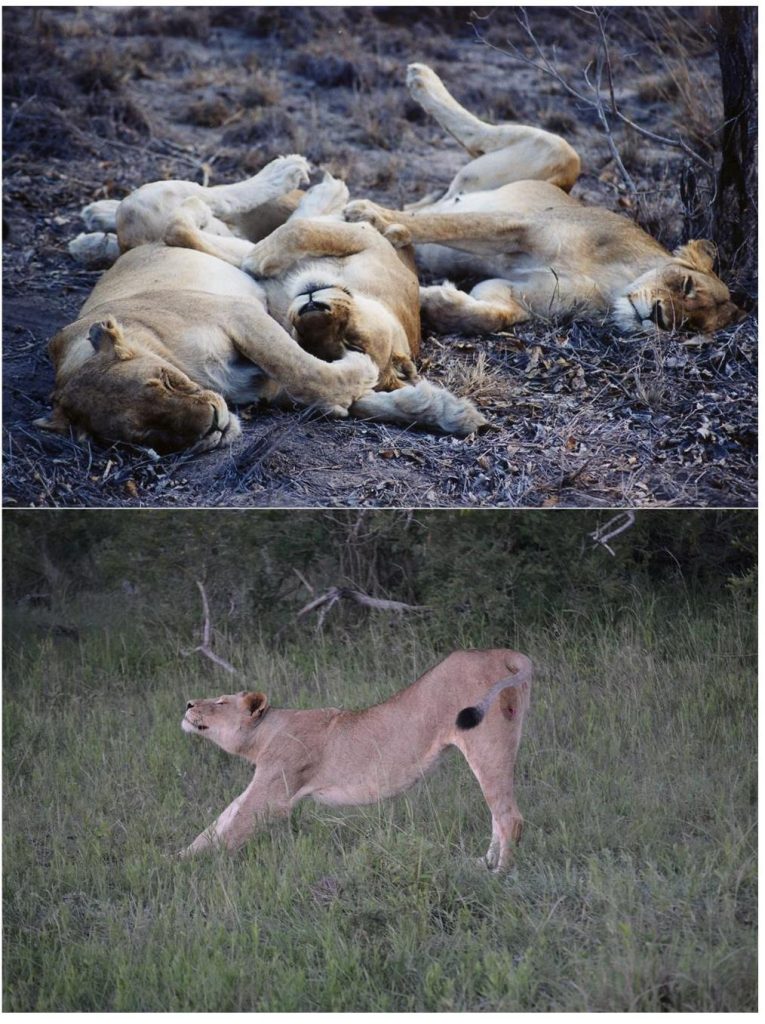
Sound
Vocalizing is one way in which the presence of lions will be verified. Lions can be quite vocal when advertising territory, when feeding or when communicating with each other. The unmistakable roar of an African lion is one of the most wonderful, awe-inspiring, and unmistakable bush sounds. They usually roar at night and often in the pre-dawn darkness with the sound on a quiet, wind-still night carrying for 3-4km. Feeding vocalizations are noisy with much growling and grunting not infrequently accompanied by the howls and whoops of hyaena during interactions with lions at a kill site. Communication between pride members is much quieter soft “humff” sounds.
Territorial behavior
Lions will mark territory by urinating on convenient bushes, rocks, or termite mounds. They will then scratch on the ground with their claws leaving distinct scuff marks in the soil.
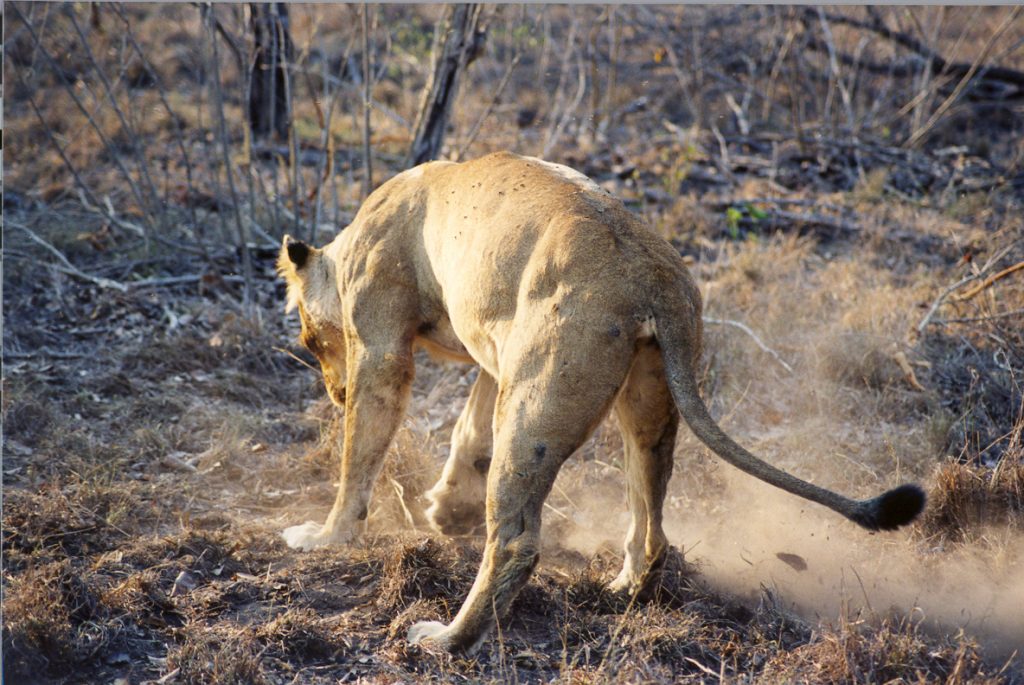
Predation, Sickness and Disease
Lion cubs are sometimes killed by male lions taking over a pride. This is referred to as infanticide. Cubs sometimes fall prey to hyenas as well. Lion populations are also being impacted by diseases such as feline aids and bovine tuberculosis, which they contract by killing and feeding off animals that are infected with TB (e.g. buffalo).

In Part 2 we will look at hunting methods with firearms and bows as well as recommended calibres and bowhunting equipment and shot placement.
References
- Cheney, C.S. (2013) The Comprehensive Guide to Tracking – Safari Press
- Mellon, L. (1975) African Hunter –Harcourt Brace Jovanovich New York and London
- Robertson, K. (1999) The Perfect Shot – Safari Press
- Robertson, K (2007) Africa’s Most Dangerous – Safari press

